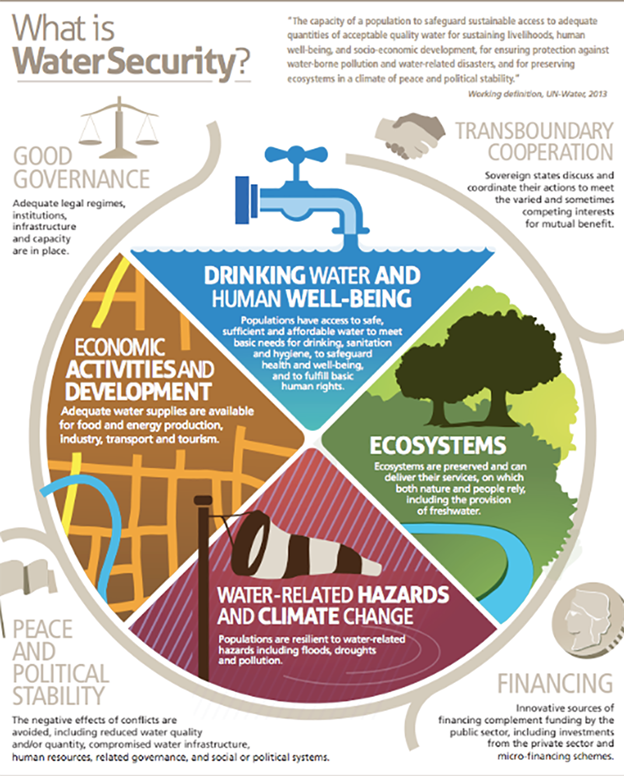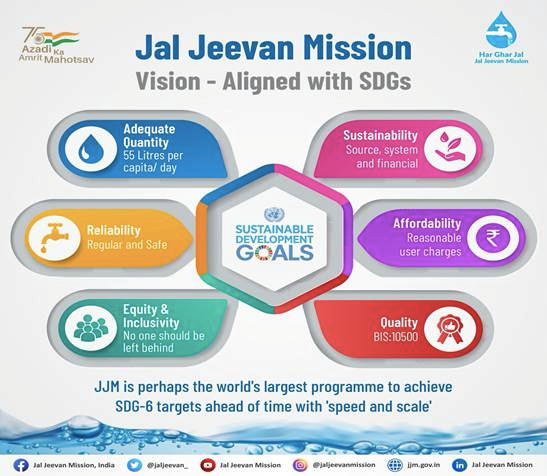The world needs to stop taking water for granted
Relevance
- GS Paper 1 Distribution of Key Natural Resources across the world.
- GS Paper 3 Disaster and disaster management.
- Tags: #upsc #gspaper1 #gspaper3 #competitive-exams #naturalresources #waterscarcity.
Why in the news?
- Sustainable water management is critical to addressing impending food and nutrition security threats.
- The theme for World Food Day (October 16) this year — ‘Water is Life, Water is Food’ — calls for urgent action in managing water wisely.
- Water availability affects every aspect of human life, especially food and nutrition security. For instance, about 60% of India’s net sown area is rainfed, contributing to 40% of the total food production.
Water, Crop production and Climate change
- About 40% of the planet’s total land area is degraded, leaving farmers with less productive land.
- Small-scale farmers, who make up more than 80% of farmers globally, are especially affected as they often lack access to finance, technology and irrigation to maintain a level of production that can sustain their livelihood.
- Extreme weather events and variability in water availability are severely affecting agricultural production, changing agro-ecological conditions and shifting growing seasons.
- Changes in rainfall and higher temperatures also affect crop productivity, reducing food availability.
Assessment done by Ministry of Environment, Forest and Climate change
- The Government of India has assessed the impact of climate change in 2050 and 2080 using climate projections and crop simulation models.
- Without adaptation measures, rainfed rice yields in India are projected to reduce by 20% in 2050, and by 47% in 2080 scenarios, while irrigated rice yields are projected to decline by 3.5% in 2050 and 5% in 2080 scenarios.
- Wheat yields are projected to decrease by 19.3% in 2050 and 40% in 2080, while kharif maize yields could decline by 18% and 23%.
- Irrigation can also be an effective measure to make agriculture more resilient, and in most cases, enable farmers to transform their livelihoods by growing, consuming and selling high-value crops such as nutritious fruits and vegetables.
- In this context, the WFP supports soil and water conservation, the building or fixing of irrigation canals, dams, ponds, and dykes, as well as flood barriers through food assistance in exchange for labor.
Climate Change Adaptation
- The FAO also supports the sustainable transformation of agri-food systems and climate-smart agriculture practices to improve water-use efficiency.
- It supported the farmer water school programme in Uttar Pradesh, which helped smallholder farmers.
- At the same time, the Andhra Pradesh Farmer Managed Groundwater Systems project reached out to 638 habitations in seven drought-prone districts, that included a hydrological monitoring programme.
Similarly, IFAD has enshrined climate change adaptation in its core strategies:
- It set ambitious targets in terms of leveraging climate financing to mitigate climate change by addressing the adverse impacts of agriculture and helping farmers to adapt to the increasing volatility of weather conditions,
- By investing in the restoration and preservation of soil health, water resources and merging modern technologies with indigenous knowledge systems to build productive and resilient production systems and value chains.
- IFAD-supported projects in Maharashtra, Odisha, Uttarakhand, Nagaland and Mizoram
Current State of Water Scarcity
World
- Only 3% of the world’s water is freshwater, and two-thirds of that is tucked away in frozen glaciers or otherwise unavailable for our use.
- As many as 87 countries are projected to become water-scarce by 2050.
- One in four people on Earth face shortages of water for drinking, sanitation, agriculture and economic development.
- Water scarcity is expected to intensify in regions like the Middle East and North Africa region, which has 6% of the global population but only 1% of the world’s freshwater resources.
India
- Although India has 16% of the world’s population, the country possesses only 4% of the world’s freshwater resources.
- In recent times, the water crisis in India has become very critical, affecting millions of people across India.
- As many as 256 of 700 districts in India have reported ‘critical’ or ‘overexploited’ groundwater levels according to the most recent Central Ground Water Board data (from 2017).
- Three-fourths of India’s rural families lack access to piped, drinkable water and must rely on unsafe sources.
- India has become the world’s largest extractor of groundwater, accounting for 25% of the total. Some 70% of our water sources are contaminated and our major rivers are dying because of pollution.
Related Initiatives
- Jal Kranti Abhiyan.
- National Water Mission.
- National Rural Drinking Water Programme.
- NITI Aayog Composite Water Management Index.
- Jal Jeevan Mission.
- Jal Shakti Abhiyan.
- Atal Bhujal Yojana
-
Recommendations
Unconventional water resources can provide major relief, provided the following strategies are followed:
- Promoting further research and practice on both technical and nontechnical aspects of unconventional water resources.
- Ensuring that unconventional waters provide benefits, not cost to the environment.
- Positioning unconventional waters as a reliable source of water in times of uncertainty.
- Supporting complementary and multidimensional approaches such as addressing water scarcity and climate change together.
Way forward
- To achieve global food and nutrition security, political commitment is needed as much as concrete investment.
- The needed policies and investments must promote innovative and proven technologies that allow farmers to increase their productivity, adapt to climate change and become more resilient.
Source: The Hindu
Mains Question
Despite India being one of the water rich countries, it struggles for water security. Discuss.





